The Relevance of Welding WPS: Making Sure Quality and Security in Your Tasks
The Relevance of Welding WPS: Making Sure Quality and Security in Your Tasks
Blog Article
The Ultimate Overview to Welding WPS Procedures: A Detailed Summary for Welders
In the elaborate world of welding, Welding Procedure Requirements (WPS) work as the backbone of making certain high quality, consistency, and safety and security in welding operations. Understanding the subtleties of creating, executing, and monitoring WPS procedures is important for welders seeking to raise their craft and meet market criteria. As we look into the various elements of a WPS and discover the intricacies of qualification and qualification, we will uncover the essential role these treatments play in the world of welding. Allow's start a trip to untangle the intricacies and importance of WPS procedures in welding techniques.
Significance of WPS Procedures
Recognizing the significance of Welding Treatment Requirements (WPS) procedures is essential for guaranteeing the high quality and stability of welded frameworks. WPS treatments act as a roadmap for welders, detailing the needed steps, parameters, and products required to achieve a sound weld. By sticking to WPS guidelines, welders can make sure uniformity in their job, causing structurally sound and reputable welds.
One of the key factors why WPS procedures are crucial is their role in keeping weld high quality and stability. Following the specified welding specifications and strategies described in the WPS aids stop issues such as porosity, fracturing, or incomplete blend, which can compromise the toughness and longevity of the weld.

Components of a WPS
A Welding Treatment Specification (WPS) normally makes up necessary parts that information the particular needs for performing a weld, making certain consistency and high quality in the welding procedure. The key elements of a WPS include essential variables such as base steels, filler steels, interpass and preheat temperature levels, welding processes, protecting gases, welding placements, and post-weld warm therapy needs.
Base steels refer to the materials being signed up with, while filler metals are utilized to fill the space between the base metals throughout welding. The welding procedure outlines the specific technique to be used, whether it's gas metal arc welding (GMAW), secured metal arc welding (SMAW), or an additional method. Welding placements specify the alignments in which welding can be executed.

Certification and Accreditation
Having actually established the essential elements of a Welding Treatment Specification (WPS), the emphasis currently changes in the direction of the essential aspects of qualification and qualification in welding practices.

Accreditation, on the other hand, is the formal recognition of a welder's certifications by a relevant certification body or organization. Welding accreditations are typically based on the specific welding procedures, materials, and positions a welder is certified to collaborate with. Holding a legitimate welding certification shows that a welder fulfills market criteria and is qualified to execute welding tasks to the needed specifications.
Creating a WPS
To develop a Welding Treatment Spec (WPS) that satisfies market criteria, mindful factor to consider of welding processes, materials, and functional criteria is important (welding WPS). The first step in creating a WPS is to determine the welding process to be utilized, such as gas steel arc welding (GMAW) or shielded steel arc welding (SMAW) Once the welding procedure is figured out, the next vital aspect is selecting the appropriate materials, taking into consideration aspects like base metal type, thickness, and joint style. Operational specifications such as welding existing, voltage, traveling speed, and try this out protecting gas make-up have to also be thoroughly specified in the WPS.

Carrying Out and Checking WPS
Upon settling the comprehensive Welding Procedure Requirements (WPS) that thoroughly details welding processes, materials, operational specifications, and quality guarantee measures, the focus moves to efficiently browse around this site applying and monitoring the well-known treatments. Execution involves making sure that all welders entailed in the project are familiar with the WPS and follow it thoroughly during the welding procedure. Effective implementation and surveillance of the WPS are crucial for ensuring the integrity, stamina, and safety and security of the bonded joints, Full Article inevitably adding to the overall success of the welding project.
Verdict
To conclude, understanding and complying with Welding Treatment Specs (WPS) is crucial for welders to make sure top quality, consistency, and safety in their job. By understanding the components of a WPS, acquiring correct certifications and certifications, developing thorough treatments, and executing and monitoring them successfully, welders can improve their skills and proficiency in welding methods. Abiding by WPS procedures is important for producing top notch welds and meeting sector criteria.
In the elaborate world of welding, Welding Procedure Requirements (WPS) serve as the backbone of ensuring quality, consistency, and security in welding operations. The welding process details the specific strategy to be used, whether it's gas steel arc welding (GMAW), secured steel arc welding (SMAW), or one more approach.To develop a Welding Treatment Spec (WPS) that meets market criteria, mindful factor to consider of welding procedures, products, and functional specifications is important. The first step in producing a WPS is to identify the welding procedure to be used, such as gas steel arc welding (GMAW) or protected metal arc welding (SMAW)Upon wrapping up the detailed Welding Treatment Requirements (WPS) that thoroughly information welding procedures, products, operational parameters, and top quality assurance procedures, the emphasis shifts to successfully applying and checking the recognized procedures.
Report this page